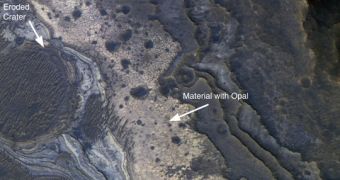Here, on Earth, opal comes in many forms and compositions, from scarcer, more precious ones, to the more common. But none of these would ever dare to compete against a tiny fragment of the material recently discovered on Mars by the Mars Reconnaissance Orbiter and confirmed by the Spirit rover, on of the two rovers that hover over Mars' equatorial surface. This discovery helps scientists get a more accurate clue on how and, more specifically, when water existed on the red planet, as well as how and where this may have influenced life to emerge.
The large opal deposits were depicted by the probe within the Gusev Crater of the Valles Marineris (Latin for “Mariner Valleys”), the largest valley known so far in our solar system, a 4,000 km long, 200 km wide and up to 7 km deep rift that scars the equatorial region of Mars, as well as in other young Martian zones. This is the 3rd form of water found on the planet so far, after the previous discoveries of ice layers and snow clouds by the Phoenix Mars Lander. This finding suggests that the planet may have held liquid water for another billion years, much longer than previously anticipated by specialists.
According to a lead scientist on the Mars Reconnaissance Orbiter team, Scott Murchie from the John Hopkins University, “Water may have existed as recently as two billion years ago. It extends the time range for liquid water on Mars, and the places where it might have supported life”.
Opals are hydrated silicates which formed by the liquid water's impact on the volcano- or asteroid collision-generated materials. “We see numerous outcrops of opal-like minerals […] around the rim of Valles Marineris and sometimes within the canyon system itself,” states Ralph Milliken from NASA's Jet Propulsion Laboratory in Pasadena, California. “What's important is that the longer liquid water existed on Mars, the longer the window during which Mars may have supported life,” he adds.

 14 DAY TRIAL //
14 DAY TRIAL //